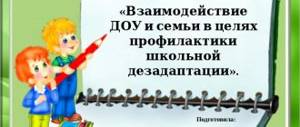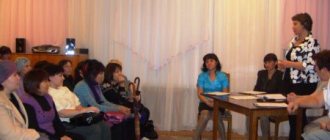Raising children in a family, presentation for a lesson on the topic
Slide 1
On the topic: “Raising children in a family” “A CHILD IS A MIRROR IN WHICH HIS PARENTS CAN SEE THEMSELVES.” Parents' meeting Prepared by V.P. Shevtsova - social worker. teacher MBOU "Boarding School No. 30"
Slide 2
Dear parents! Today we have another parent meeting. We need to think about the question: What do you want your child to look like in a few years, what role will your family play in his development?
Slide 3
Traditionally, the main institution of education is the family; what a child acquires in the family during childhood, he retains throughout his entire subsequent life.
Slide 4
It is in the family that the child receives his first life experience, makes his first observations and learns how to behave in various situations.
Slide 5
It is very important that what parents teach the child is supported by specific examples, so that he sees that in adults, theory does not diverge from practice. (If your child sees that his mom and dad, who tell him every day that lying is wrong, without noticing it themselves, deviate from this rule, all upbringing can go down the drain).
Slide 6
Each parent sees in their children their continuation, the realization of certain of their attitudes or ideals.
Slide 7
Each family objectively develops a certain system of education, which is not always realized by family members.
Slide 8
Basically, the following parenting styles are distinguished: democratic, authoritarian, permissive.
Slide 9
In a democratic style, the interests of the child are taken into account first. “Consent” style. In an authoritarian style, parents impose their opinions on the child. “Suppression” style. With the permissive style, the child is left to his own devices.
Slide 10
The family is the main environment for personality formation and I would especially like to note the importance of the criminogenic impact of the family on the child. The family has great opportunities to keep a child from crime, unfortunately, these opportunities are often not realized and the reasons for them are as follows:
Slide 11
indifferent attitude of parents towards children, lack of control over their behavior; pedagogical and legal illiteracy of parents, their inability to exert the right influence on children; frequent conflicts in the family, leading to contradictions in family pedagogy; loss of authority by parents, mutual alienation; parents do not maintain contact with the school.
Slide 12
The main factors in preventing crime among adolescents are: the presence of close mutual understanding in the family; friendly, trusting relationships between parents and children; constant, but reasonably permissible, control over the behavior of minor children.
Slide 13
Thank you for your attention!
Presentation on the topic of education and child development
Description of the presentation by individual slides:
1 slide
Slide description:
Upbringing
2 slide
Slide description:
The art of education has the peculiarity that it seems familiar and understandable to almost everyone, and even easy to others, and the more understandable and easier it seems, the less a person is familiar with it, theoretically or practically. K.D. Ushinsky
3 slide
Slide description:
Education In a broad pedagogical sense, education is a specially organized, purposeful and controlled influence of the team, educators on the student in order to develop specified qualities in him, carried out in educational institutions and covering the entire educational process. In a narrow pedagogical sense, education is the process and result of educational work aimed at solving specific educational problems.
4 slide
Slide description:
The transfer of experience from older generations to younger ones has existed since ancient times. Each generation of people solves three major problems.
Firstly, to master the experience of previous generations, secondly, to enrich and increase this experience, and thirdly, to pass it on to the next generation.
Social progress became possible only because each new generation mastered the experience of its ancestors, enriched it and passed it on to its descendants.
5 slide
Slide description:
Goals and objectives The most important task of education is to identify inclinations and talents, development in accordance with the individual characteristics of a person, his abilities and capabilities.
Today, the main goal of high school is to promote the mental, moral, emotional and physical development of the individual, and to fully reveal his creative potential.
Conscious assimilation of a knowledge system contributes to the development of logical thinking, memory, attention, imagination, mental abilities, inclinations and talents.
6 slide
Slide description:
Principles of education Education is a certain system of requirements for the education process, there are many of them and each teacher has the right to use only some of them.
7 slide
Slide description:
Physical education is an integral part of almost all educational systems. Physical education contributes to the development in young people of the qualities necessary for successful mental and labor activity.
Labor education covers those aspects of the educational process where labor actions are formed, production relations are formed, and tools and methods of using them are studied.
Labor in the process of education also acts as a leading factor in personal development.
8 slide
Slide description:
Moral education - forms moral concepts, judgments, feelings and beliefs, skills and habits of behavior that correspond to the norms of society.
The moral education of the younger generation is based on both universal human values, enduring moral norms developed by people in the process of historical development of society, and new principles and norms that have arisen at the present stage of social development.
Slide 9
Slide description:
Aesthetic (emotional) education is a basic component of the goals of education and the educational system, summarizing the development of aesthetic ideals, needs and tastes among students.
The tasks of aesthetic education can be conditionally divided into two groups - the acquisition of theoretical knowledge and the formation of practical skills.
The first group of tasks solves the issues of familiarization with aesthetic values, and the second - active inclusion in aesthetic activities
10 slide
Slide description:
Modern pedagogical practice is guided by two main concepts of educational goals: The pragmatic concept, which has been established since the beginning of the 20th century. in the USA and persists here to this day under the name “education for survival.”
According to this concept, the school should educate, first of all, an effective worker, a responsible citizen and a reasonable consumer.
The humanistic concept, which has many supporters in Russia and the West, proceeds from the fact that the goal of education should be to help the individual realize all the abilities and talents inherent in him, in realizing his own “I”.
11 slide
Slide description:
The present time represents the era of development of HUMANISTIC PEDAGOGY.
12 slide
Slide description:
Pedagogical experiment or practice Principles of education Pedagogical theory or concept
Slide 13
Slide description:
PRINCIPLES OF HUMANISTIC EDUCATION
Slide 14
Slide description:
According to the concept of humanistic pedagogy, education should be aimed at the development of creative individuality and personality. The object of education is a person and his abilities.
15 slide
Slide description:
II. The educational process must take place in accordance with the characteristics of the surrounding culture and allow those being educated to assimilate these cultural characteristics, since a person can adapt to society only if he knows its cultural values.
Slide 17
Slide description:
IV. The principle of education is the connection between education and work, society and the personal experience of the student.
18 slide
Slide description:
V. The principle of education is the obligatory stay in the team during the education process, participation in its activities and the participation of the team itself in the formation of the personality of each of the students.
Slide 19
Slide description:
VI. The principle of education implies highlighting only the positive aspects of the student and building the educational process based on them.
20 slide
Slide description:
CONCLUSION: Education must necessarily strive to develop the personality of students based on their individual and age characteristics in the process of mastering culture.
Select a book with a discount:
OVER 58,000 BOOKS AND WIDE SELECTION OF STATIONERY SUPPLIES! INFOLABKA
Infolavka - a bookstore for teachers and parents from the Infourok project
Professional retraining course
Primary school teacher
Refresher course
Refresher course
Find material for any lesson by indicating your subject (category), class, textbook and topic:
You can also select the type of material:
Brief description of the document:
Education is the purposeful formation of a personality in order to prepare it for participation in public and cultural life in accordance with sociocultural normative models. According to academician I. P. Pavlova, education is a mechanism for ensuring the preservation of the historical memory of the population.
- Human education is, among other things, the subject of pedagogy as a science.
The goals of education are expected changes in a person, carried out under the influence of specially prepared and systematically carried out educational actions and actions.
In a broad pedagogical sense, education is a specially organized, purposeful and controlled influence of the team, educators on the educated person with the aim of developing specified qualities in him, carried out in educational institutions and covering the entire educational process.
In a narrow pedagogical sense, education is the process and result of educational work aimed at solving specific educational problems.
Source: https://luxeth.ru/prezentacija-na-temu-vospitanie-razvitie-rebenka/
Presentation Presentation Family and child
The most common forms of deviant behavior: Addictive behavior - Abuse of substances that cause states of change in mental activity (alcoholization, drug addiction, smoking, etc.) In adolescence, during puberty, behavior is largely determined by the reactions of emancipation, grouping, characteristic of this period, hobbies and emerging sexual attraction (Lichko A. E., Bitensky V. S., 1991, pp. 35 - 36). The same factors can contribute to the involvement of adolescents in groups where the use of alcohol, tobacco and drugs is practiced, provided that these groups will satisfy any needs of the adolescent that he cannot satisfy in other groups. The desire for emancipation leads a teenager to “freedom poisoning,” in which drinking, smoking, and drug use are the most common. Substance abuse is facilitated by communicative hobbies - thoughtless communication with peers, exchange of insignificant information that does not require intellectual processing. An unsatisfied need for self-affirmation leads to attempts to realize oneself not only in creativity, but also in negative forms of activity - violence, crime, or leads to escape into alcohol, drugs, and life. Auto-aggressive behavior is a type of aggressive behavior in which hostile actions are directed by a person towards himself. Auto-aggression can manifest itself in causing physical harm to oneself, and in especially severe cases, in suicide attempts. One of the most common types of self-aggressive behavior among adolescents and young adults is cutting themselves, most often on the wrists. Trauma specialist Van der Kolk of the Massachusetts Mental Health Center conducted a study of patients who cut themselves. It turned out that most of them spent their childhood in an unhealthy family atmosphere: their parents neglected their responsibilities or even used physical or sexual violence against their children. Such patients often mentioned situations of systematic bullying by teachers and classmates during their schooling. According to American psychotherapist Linehan, autoaggressive people have low self-esteem and tend to devalue themselves and their feelings. This behavior is often a consequence of ignoring or ridiculing the child's need to share his experiences.





